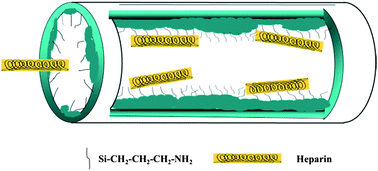Fabricating a sustained releaser of heparin using SBA-15 mesoporous silica†
Abstract
The sustained release of heparin in sufficient amounts and over long time is a challenge to drive the development of functional materials. In this paper SBA-15 mesoporous silica is selected in the search for a favorable morphology and optimized surface state for the sustained release of heparin. In situ carbonization of the template in the as-synthesized sample enables SBA-15 to possess narrowed channels with rougher surfaces, while modification with (aminopropyl)triethoxysilane (APTES) through a one-pot synthesis offers SBA-15 with positive charges to attract heparin through electro-static interactions. The structure of modified SBA-15 samples is assessed with XRD (powder X-ray diffraction analysis), nitrogen adsorption–desorption and electron microscopy techniques, and their performance is evaluated in adsorption and release of heparin. These modifications improve the heparin adsorption in SBA-15 and thus promote its sustained release, prolonging the release-equilibrium time up to 60 days. Among them, the SBA-15 sample modified with APTES can trap three times as much heparin as the parent SBA-15, and the release ratio is elevated to 80% (that of SBA-15 is 38%), realizing the best performance of controlling heparin release to date.


 Please wait while we load your content...
Please wait while we load your content...